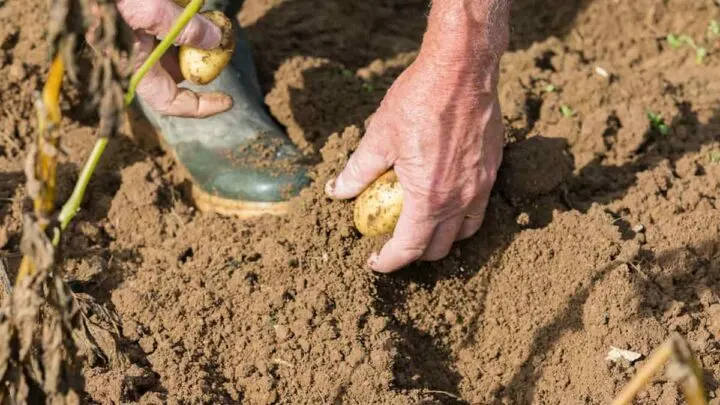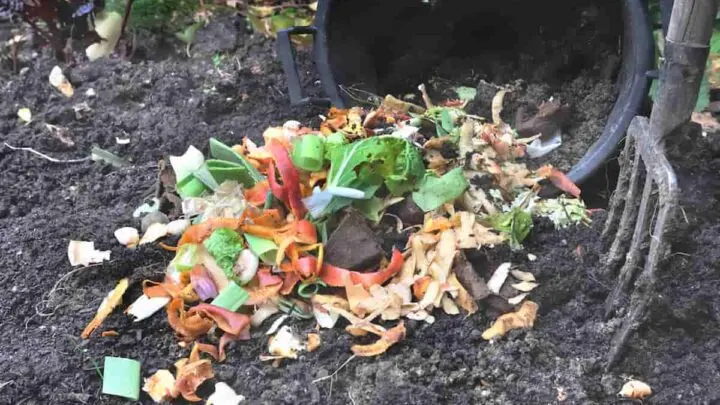You’ve just planted your potatoes, and you want to give your potatoes the best chance of growing strong. You read about ericaceous compost and wonder, can you grow potatoes in ericaceous compost?
You can grow potatoes in ericaceous compost. Potatoes may even grow better in slightly acidic compost, like ericaceous compost.
Everyone has a different method for growing the best potatoes in their at-home garden, but ericaceous compost may be the best choice for you. Continue reading to learn about ericaceous compost and why it may be the way to go for your garden.

What Is Ericaceous Compost
Let’s first talk about ericaceous compost since it might be something you haven’t heard of before.
Ericaceous compost is compost with a low pH level, meaning that it is acidic.
You can buy this compost in the gardening section, but you can make it at home with a regular compost base too.
You can add the following acidic materials to your compost bin to make ericaceous compost:
- Pine needs
- Saw dust
- Coffee grounds
- Sand
These are all naturally acidic organic materials, so you are adding acidity to the compost that is not acidic on its own. It’s kind of like making a cake!
Can I Use Ericaceous Compost On All Plants
Not all plants grow well with ericaceous compost, so do not add this type of compost to all your plants without doing research first.
When you find something new and different, you might be tempted to put it on all your plants, but not all plants grow well with increased acidity.
Here are a few plants that will do well in more acidic soil:
- Raspberries, blueberries, and cranberries
- Magnolia
- Daffodils
- Azaleas
- Oak
- Japanese Maple
As you can see, trees and flowers overwhelm the list of plants that love acidic soil, but this list does not contain every fruit and vegetable that also enjoys acidic soil.
Potatoes are one crop that has two camps: those who believe acidic soil is good for potatoes and those who think that it isn’t necessary.
What Is the Best Compost for Growing Potatoes
Potatoes do best in loam soil, which is equally made of sand and silt.
Before we get into what compost is best for potatoes, let’s look at loam soil to get an idea of where we are going. Loam soil has sand and silt in it.
Now, let’s see if you were paying attention. What material is good to add to compost to make it more acidic?
If you said sand, then you are correct!
The sand in loam soil does not make it highly acidic, but knowing this will help you know what kind of compost is best.
Most gardeners say that mixing potting soil and compost with sand will make for one of the best composts for potatoes.
In this case, you can make ericaceous compost at home and mix it in with some potting soil to make a compost concoction for your potatoes. Make sure you add sand as one of the organic materials to get the right acidity for your potato plants.

How To Plant Potatoes
Potatoes are a relatively easy crop to plant at home.
Potatoes can be one of the earliest crops you plant in the season. You can plant them a week or two after the season’s last frost. You need to wait long enough that the ground thaws enough to dig into.
Purchase seed potatoes that have eyes. These are different than old potatoes from the grocery store, so don’t simply toss your old potatoes in the ground and think they will grow.
Plant your seed potatoes in trenches in your garden, giving each seed potato about 3 feet of room so they can grow properly.
Dig down about 12 inches and add your seed, then 3 or 4 inches of soil on top. The trench will come in handy because you’ll come back in 2 weeks to add another 3 inches of soil. You’ll keep repeating the process until your trenches are back at ground level.
Potatoes take some extra work to get set, but once they are, it’s all about caring for your potatoes.
Caring For Potatoes
Like with any crop, potatoes have particular needs to keep them growing well. Caring for your potatoes ensures that you will have the best crop possible when it is time to harvest your potatoes.
Sunlight
Potatoes grow underground, but your crops need at least 6 hours of sunlight every day, so you should plant your potatoes where there is ample sunlight.
Your potatoes can tolerate partial sunlight as well but not grow as well without hours of sunlight.
Shoots from your potato plants will eventually break the surface of the soil, and so sunlight is especially important for these shoots to continue to grow.

Soil
We’ve already covered in some detail about what kind of soil potatoes like, but it is also important to note that the soil needs to be well-drained too.
The sand mixed in the soil will help it drain, which is another helpful reason why you need to add sand into your compost.
Soil that doesn’t drain well may rot your potatoes or increase the chances of your potatoes acquiring diseases.
Water
Potato crops need about an inch of water every week.
Most places will not get an inch of natural rainfall per week, so you will need to supplement rainfall with water from a garden hose.
Avoid overwatering your potatoes early in the season because it can cause the vegetables to become misshapen early on. Too much water later in the season can cause your potatoes to rot or grow scabs.
Optimal Temperatures
Potato plants thrive in cooler weather.
It should be no more than 80 degrees during the day when you are growing your potatoes. Temperatures can dip to as low as 50 degrees at night, and your potato plants will still be happy.
Potatoes can be planted and will start to grow when temperatures are consistently above 45 degrees during the day and at night.
Fertilizer
You should start to fertilize your potato plants two weeks after planting them and then every four weeks after that.
Potatoes grow underground, so you will want to purchase a fertilizer that is high in potassium and phosphorus instead of nitrogen. Any fertilizer you get will need to be watered into the soil to have the best effects on your tomato plants.
Stop fertilizing your potatoes two weeks before you plan to harvest them.
Final Thoughts
If you aren’t one for testing your soil, then all the talk about acidity may be a lot to absorb – no pun intended.
For the casual gardener, worrying about acidity, phosphorus, and potassium is too much to handle to grow crops producing 10 or 20 potatoes.
As you become more sophisticated with your gardening and more comfortable in your abilities, you may start to dabble with ericaceous compost and be able to taste the difference once you harvest your potatoes.
It might feel like a bombardment of information to learn about compost and acidity when you are still crossing your fingers that your crops will grow at all, but it will increase the quality of your crops, which I’m sure is the hope!

Hi there, my name is Allie and welcome to my blog; GareningWithAllie!
Much of what you see written here is just our personal experiences with gardening. Along with the content I write here, there is also a unique collection of gardening topics covered by some of our close friends. I hope you find everything you read here to be helpful, informative, and something that can make your gardening journey the most lovely experience ever! With that said, Happy Gardening!
